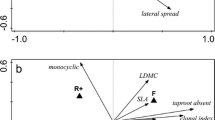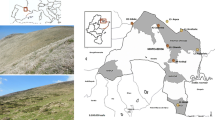Abstract
For root hemiparasites, host plants are both the source of water and nutrients below-ground, but competitors for light above-ground. Hemiparasites can reduce host biomass, and in this way considerably affect the whole plant community. To investigate these effects, we carried out two experiments in an oligotrophic meadow with a native population of Rhinanthus minor. In the first experiment, removal of R. minor was combined with fertilization in a factorial design, and in the second one, we manipulated R. minor density by thinning. The presence of R. minor decreased the biomass of its host community, mostly by suppressing grasses. In this way, the species was able to counterbalance the effect of fertilization, which increased community biomass and in particular that of grasses. Neither the presence of R. minor nor fertilization affected the total number of species or the Shannon-Wiener diversity index (H’) of the host community. However, H’ of grasses was higher and H’ of forbs (non-leguminous dicots) was lower in the presence of R. minor. Reduction of grasses by R. minor favored mainly the dominant forb Plantago lanceolata, which partly acquired the role of a competitive dominant. Effects of R. minor on community diversity seem to be highly dependent on the relative sensitivities of dominant and subordinate species. Fertilization increased the mortality of seedlings, resulting in a lower number of flowering plants. However, surviving individuals on average produced more flowers. Thinning resulted in lower mortality of R. minor plants. This indicates that intraspecific competition in R. minor populations results in negative density dependence.





Similar content being viewed by others
References
Ameloot E, Verheyen K, Hermy M (2005) Meta-analysis of standing crop reduction by Rhinanthus spp. and its effect on vegetation structure. Folia Geobot 40:289-310
Ameloot E, Verlinden G, Boeckx P, Verheyen K, Hermy M (2008) Impact of hemiparasitic Rhinanthus angustifolius and R. minor on nitrogen availability in grasslands. Pl & Soil 311:255–268
Blažek P (2009) Čím je omezováno rozšíření poloparazitické rostliny kokrhele menšího Rhinanthus minor? (Which factors limit the distribution of hemiparasitic plant Rhinanthus minor?). Bc. thesis, Faculty of Science, University of South Bohemia, České Budějovice. Available at: http://stag-web.jcu.cz/apps/stag/diplom/index.php?download_this_unauthorized=7717
Bullock JM, Pywell RF (2005) Rhinanthus: a tool for restoring diverse grassland? Folia Geobot 40:273–288
Cameron DD, Seel WE (2007) Functional anatomy of haustoria formed by Rhinanthus minor: linking evidence from histology and isotope tracing. New Phytol 174:412–419
Cameron DD, Hwangbo J, Keith AM, Geniez J, Kraushaar D. Rowntree J, Seel WE (2005) Interactions between the hemiparasitic angiosperm Rhinanthus minor and its hosts: from the cell to ecosystem. Folia Geobot 40:217–229
Cameron DD, Coats AM, Seel WE (2006) Host and non-host resistance underlie variable success of the hemi-parasitic plant Rhinanthus minor. Ann Bot (Oxford) 98:1289–1299
Cameron DD, Geniez JM, Seel WE, Irving LJ (2008) Suppression of host photosynthesis by the parasitic plant Rhinanthus minor. Ann Bot (Oxford) 101:573–578
Davies DM, Graves JD (2000) The impact of phosphorus on interactions of the hemiparasitic angiosperm Rhinanthus minor and its host Lolium perenne. Oecologia 124:100–106
Davies DM, Graves JD, Elias CO, Williams PJ (1997) The impact of Rhinanthus spp. on sward productivity and composition: implication for the restoration of species-rich grasslands. Biol Conservation 82:87–93
de Hullu E (1985) The influence of sward density on the population dynamics of Rhinanthus angustifolius in a grassland succession. Acta Bot Neerl 34:23–32
de Hullu E, Bouwer T, ter Borg SJ (1985) Analysis of the demography of Rhinanthus angustifolius populations. Acta Bot Neerl 34:5–22
Fibich P, Berec L, Lepš J (2010) The model of population dynamics of root hemiparasitic plants along a productivity gradient. Folia Geobot 45 (this issue) doi:10.1007/s12224-010-9080-7
Gibson CC, Watkinson AR (1989) The host range and selectivity of parasitic plant: Rhinanthus minor L. Oecologia 78:401–406
Gibson CC, Watkinson AR (1991) Host selectivity and the mediation of competition by the root hemiparasite Rhinanthus minor. Oecologia 86:81–87
Gibson CC, Watkinson AR (1992) The role of the hemiparasitic annual Rhinanthus minor in determining grassland community structure. Oecologia 89:62–68
Grime JP (1979) Plant strategies and vegetation processes. John Wiley, Chichester
Jiang F, Jeschke WD, Hartung W, Cameron DD (2008) Does legume nitrogen fixation underpin host quality for the hemiparasitic plant Rhinanthus minor? J Exp Bot 59:917–925
Joshi J, Matties D, Schmid B (2000) Root hemiparasites and plant diversity in experimental grassland communities. J Ecol 88:634–644
Kubát K, Hrouda L, Chrtek J jun, Kaplan Z, Kirschner J, Štěpánek J (eds) (2002) Klíč ke květeně České republiky (Key to the flora of the Czech Republic). Academia, Praha
Lepš J (1993) Taylor’s power law and measuring variation in the size of populations in space and time. Oikos 68:349–356
Lepš J (2004) Variability in population and community biomass in a grassland community affected by environmental productivity and diversity. Oikos 107:64–71
Lepš J, Šmilauer P (2003) Multivariate analysis of ecolological data using CANOCO. Cambrige University Press, Cambrige
Matthies D (1995a) Parasitic and competitive interactions between the hemiparasites Rhinanthus serotinus and Odontites rubra and their host Medicago sativa. J Ecol 83:245–251
Matthies D (1995b) Host-parasite relations in the obligate hemiparasite Melampyrum arvense. Flora 190:383–394
Matthies D (1996) Interactions between the root hemiparasite Melampyrum arvense and mixtures of host plants: heterotrophic benefit and parasite-mediated competition. Oikos 75:118–124
Matthies D (1997) Host-parasite interactions in Castilleja and Orthocarpus. Canad J Bot 75:1252–1260
Matthies D (1998) Influence of the host on growth and biomass allocation in the two facultative root hemiparasites Odontites rubra and Euphrasia minima. Flora 193:187–193
Matthies D (2003) Positive and negative interactions among individuals of root hemiparasite. Pl Biol 5:79–84
Matthies D, Egli P (1999) Response of root hemiparasite to elevated CO2 depends on host type and soil nutrients. Oecologia 120:156–161
Mizianty M (1975) Wplyw Rhinanthus serotinus (Schönheit) Oborny na produkcje i sklad florystyczny lakowego zespolu roślinnego (Influence of Rhinanthus serotinus (Schönheit) Oborny on the productivity and floristic composition of the meadow plant association). Fragm Florist Geobot 21:491–505
Phoenix GK, Press MC (2005) Linking physiological traits to impacts on community structure and function: the role of root hemiparasitic Orobanchaceae (ex-Scrophulariaceae). J Ecol 93:67–78
Pielou EC (1969) An introduction to mathematical ecology. Wiley, New York
Prati D, Matthies D, Schmid B (1997) Reciprocal parasitation in Rhinanthus serotinus: a model system of physiological interaction in clonal plants. Oikos 78:221–229
Pywell RF, Bullock JM, Walker KJ, Coulson SJ, Gregory SJ, Stewenson MJ (2004) Facilitating grassland diversification using the hemiparasitic plant Rhinanthus minor. J Appl Ecol 41:880–887
Quested HM, Cornelissen JHC, Press MC, Callaghan TV, Aerts R, Trosien F, Riemann P, Gwynn-Jones D, Kondratchuk A, Jonasson SE (2003) Decomposition of sub-arctic plants with differing nitrogen economies: A functional role for hemiparasites. Ecology 84:3209–3221
Rabotnov TA (1959) Vlijanie pogremka (Rhinanthus major Ehrh.) na urozaj i sostav travostoja pojmennogo luga (The effect of Rhinanthus major Ehrh. upon the crops and the composition of the floodland meadows). Byull Moskovsk Obshch Isp Prir, Otd Biol 64:105–107
Rümer S, Cameron DD, Wacker R, Hartung W, Jiang F (2007) An anatomical study of the haustoria of Rhinanthus minor attached to roots of different hosts. Flora 202:194–200
Seel WE, Press MC (1993) Influence of the host on three sub-Arctic annual facultative root hemiparasites. I. Growth, mineral accumulation and above-ground dry-matter partioning. New Phytol 125:131–138
Seel WE, Press MC (1996) Effects of repeated parasitism by Rhinanthus minor on growth and photosynthesis of a perennial grass, Poa alpina. New Phytol 134:495–502
Smith D (2000) The population dynamics and community ecology of root hemiparasitic plants. Amer Naturalist 155:13–23
StatSoft, Inc. (1999) STATISTICA for Windows (Computer program manual). Version 5.5. Available at: http://www.statsoft.com
StatSoft, Inc. (2002) STATISTICA for Windows (Computer program manual). Version 6.1. Available at: http://www.statsoft.com
ter Braak CJF, Šmilauer P (2002) Reference manual and user’s guide to Canoco for Windows: Software for Canonical Community Ordination. Microcomputer Power, Ithaca
van Hulst R, Shipley B, Trériault A (1987) Why is Rhinanthus minor (Scrophulariaceae) such a good invader? Canad J Bot 11:2373-2379
Walker KJ, Stevens PA, Stevens DP, Mountford JO, Manchester SJ, Pywell RF (2004) The restoration and re-creation of species-rich lowland grassland on land formerly managed for intensive agriculture in the UK. Biol Conservation 119:1–18
Westbury DB (2004) Rhinanthus minor L. J Ecol 92:906–927
Westbury DB, Dunnett NP (2007) The impact of Rhinanthus minor in newly established meadows on a productive site. Appl Veg Sci 10:121–129
Westbury DB, Dunnett NP (2008) The promotion of grassland forb abundance: A chemical or biological solution? Basic Appl Ecol 9:653–662
Westbury DB, Davies A, Woodcock BA, Dunnett NP (2006) Seeds of change: The value of using Rhinanthus minor in grassland restoration. J Veg Sci 17:435–446
Zobel M (1997) The relative role of species pools in determining plant species richness. An alternative explanation of species coexistence? Trends Ecol Evol 12:266–269
Acknowledgments
The research was supported by grants GAAV IAA601410805, AV0Z60660521, AV0Z60050516, and MSMT 6007665801. We are extremely grateful to Diethar Matthies and Renate Wesselingh for their helpful comments on earlier drafts of the manuscript. We also thank Dr. Keith Edwards for improving the language.
Author information
Authors and Affiliations
Corresponding author
Rights and permissions
About this article
Cite this article
Mudrák, O., Lepš, J. Interactions of the Hemiparasitic Species Rhinanthus minor with its Host Plant Community at Two Nutrient Levels. Folia Geobot 45, 407–424 (2010). https://doi.org/10.1007/s12224-010-9078-1
Received:
Revised:
Accepted:
Published:
Issue Date:
DOI: https://doi.org/10.1007/s12224-010-9078-1




